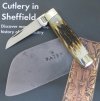- Joined
- May 9, 2010
- Messages
- 8,925
"Ah!!! I love the smell of Horn in the morning!!"

"smells like victory"
"Ah!!! I love the smell of Horn in the morning!!"

Woah ! I got behind reading this topic and missed all of this ! Very cool, Jack !!!

"smells like victory"
You got it!!!


Woah ! I got behind reading this topic and missed all of this ! Very cool, Jack !!!

Yeah jack really set the bar here. Stunning knives for sure
They look great, Jack! I can't wait! Thanks for making this possible!

I have a fit/finish/QA question for A. Wright produced Lambsfoots...a little off topic from the last few pages of discussion, but I know it has come up previously. Can anyone comment on blade curvature on their knives?
I ordered a horn handled knife that showed up not as well put together as I would have liked, but I knew previous discussion from this thread about folks culling through knives in person to find good examples. With that in mind, I wouldn't have been disappointed, except for the bends in the knife. The handle was bent in one direction and the blade in the opposite direction, such that it actually had blade rub against one liner in the middle of the blade and the opposite liner at the tip. I didn't care about the blade rub, but the blade curvature means that I would never be able to sharpen it on a flat bench stone.
I absolutely loved the profile of the knife, both in hand and aesthetically, so I took a chance on another one...plain rosewood from a different seller. This knife is better finished, blade centered, but still with some curvature. Just enough so that it wouldn't lay on flat bench stone.
Getting to the point, do folks have examples with straight blades? Or do I just have to accept sharpening on a rod or narrow stone?
Archie, I have about ten A.Wright knives, and have never seen your problem!
It's such a pain to send it back, but I probably would anyway!
I'd like to see a pic, but it sounds far from acceptable! I bought a Case that had a problem like you describe, and the factory replaced it!
I asked them about it when I visited the factory. They told me that every once in a while, a blade will curl from an uneven heat treat, and it can occur as the finished knife sits in a box for a week, a month, or a year!!


Thanks for the feedback, guys. I think I'll be keeping the rosewood example because the bend really is subtle...I probably wouldn't have noticed, but I was looking for it since the previous knife was so bad. After the explanations above, I also won't be checking any of my existing knives with a straight edge.
I wonder if a slight warp in a blade is more noticeable on a straight edged blade like a lambsfoot. When I'm freehand sharpening on a stone, I'll sometimes notice that my edge shows a variation in the height of the bevel, as in your picture, Chin. Maybe the same thing happens sometimes on blades with a belly like a clip or spear, but it's harder to know if it's the blade or my limited sharpening skills.
Thanks for the feedback, guys. I think I'll be keeping the rosewood example because the bend really is subtle...I probably wouldn't have noticed, but I was looking for it since the previous knife was so bad. After the explanations above, I also won't be checking any of my existing knives with a straight edge.

I wonder if a slight warp in a blade is more noticeable on a straight edged blade like a lambsfoot. When I'm freehand sharpening on a stone, I'll sometimes notice that my edge shows a variation in the height of the bevel, as in your picture, Chin. Maybe the same thing happens sometimes on blades with a belly like a clip or spear, but it's harder to know if it's the blade or my limited sharpening skills.I know I've bought used knives that seemed fine until I went to sharpen them and realized someone had done some 'light prying'.
Not enough to affect use, but enough to notice against a flat stone.

youve choosen!
Same knife as shown previously, the first one they made, the prototype so to speak, I still had to pay for it!
wouldnt have it any other way, is it signed special, to mark off 1/30? :O

